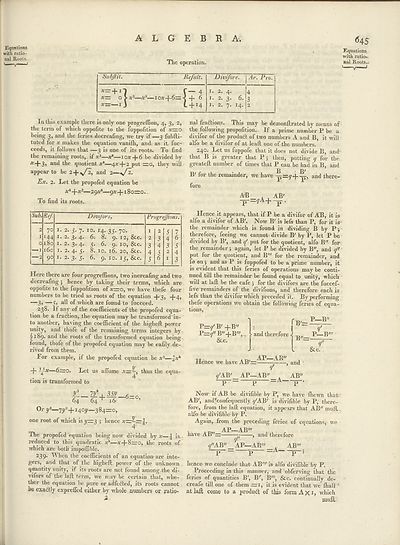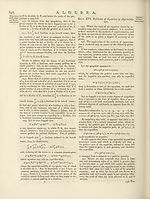Encyclopaedia Britannica, or, a Dictionary of arts, sciences, and miscellaneous literature : enlarged and improved. Illustrated with nearly six hundred engravings > Volume 1, A-AME
(689) Page 645
Download files
Complete book:
Individual page:
Thumbnail gallery: Grid view | List view

ALGEBRA.
Equations
with ratio¬
nal Roots.
The operation.
Subjiit.
KeJ'ult.
*=+n r-
x— o >#3—x2—io»-f-6=< -f-
x=—l} i+l
4
6
+ T4
Divifors. Ar. Pro
i. 2. 4.
1. 2. 3. 6.
I. 2. 7. 14.
645
Equations
with ratio¬
nal Roots^
111 this example there is only one progreffion, 4, 3, 2,
the term of which oppofite to the fuppofition of x~o
being 3, and the feries decreafing, wre try if—3 fubfti-
tuted for x makes the equation vanifh, and as it fuc-
ceeds, it follows that —3 is one of its roots. To find
the remaining roots,, if x3—x1—10^ + 6 be divided by
antl the quotient x*—^x-{~2 put =0, they will
appear to be 2 + ^2, and 2—>s/2.
Ex. 2. Let the propofed equation be
x4-\-x3—2gx1—9#+180=0,.
To find its roots.
Here there are four progreffions, two increafing and two
decreafing j hence by taking their terms, which are
oppofite to the fuppofition of x=o, we have thefe four
numbers to be tried as roots of the equation +3, -{-4,
—3> —5* °f which are found to fucceed.
238. It any of the coefficients ^)f the propofed equa¬
tion be a fra6Hon, the equation may be transformed in¬
to another, having the coefficient of the higheft power
unity, and thole of the remaining terms integers by
§189. and the roots of the transformed equation being
found, thole of the propofed equation may be eafily de¬
rived from them.
For example, if the propofed equation be x3—^x*
}Ax—6—o. Let us affiime xzz-, thus the equa-
• • „ 4
tion is transformed to
y* ly' , 3sy
65“ 65 + 76 _6-0’
°r y3—7y2 +14031—384=0,
one root of which is y=3 ; hence x~^-~^.
The propofed equation being now divided by x—| is,
reduced to this quadratic x*—x-\-8=o, the roots of
which are both impoffilde.
239* ^ hen the coefficients of an equation-are inte¬
gers, and that of the higheft power of the unknown
quantity unity, if its roots are not found among the di¬
vifors of the laft term, we mav be certain that, whe-
ther the equation be pure or adfefted, its roots cannot
be exactly exprelfed either by whole numbers or ratio¬
2
nal fractions. This may be demonftrated by means of
the following propofition. If a prime number P be a
divifor of the prodiuft of two numbers A and B, it will
alfo be a divifor of at leaft one of the numbers.
240. Let us fuppofe that it does not divide B, and
that B is greater that P j then, putting q for the
greateft number of times that P can be had in B, and
B 1 TV
B' for the remainder, we have ^=9 + ^, and there-
P P
fore
AB
=?A-J-
AB'
P '
Hence it appears, that if P be a divifor of AB, it is
alfo a divifor of AB'. Now B' is lefs than P, for it is
the remainder which is found in dividing B by P j
therefore, feeing we cannot divide B' by P, let P be
divided by B', and q' put for the quotient, alfo B" for
the remainder 5 again, let P be divided by B", and q'!
put for the quotient, and B'" for the remainder, and
to on 5 and as P is fuppofed to be a prime number, it
is evident that this feries of operations may be conti¬
nued till the remainder be found equal to unity, which
will at laft be the cafe ; for the divifors are the fuccef-
five remainders of the divifions, and therefore each is
lefs than the divifor which preceded it. By performing
thefe operations we obtain the following feries of equa¬
tions,
Prr/B' +B"
Y=q" B"-j-B"/,
&.C.
1> and therefore
P—B"
y'
P—B'"
tt , . t>, AP—AB" ,
Hence we have AB'rr , and
9
g'AW AP—AB" , AB"
— = p—=A p-.
Now if AB be divifible by P, we have fhewn that
AB', andfconfequently q'AW is divifible by P, there¬
fore, from the laft equation, it appears that AB" mull.
alio be divifible by P.
Again, from the preceding feries of equations, we
AP AB'"
have AB"— , and therefore
9
?"AB"_AP—AB'" 4 AB'"
P “ P ~A P~5
hence we conclude that AB'" is alfo divifible by P.
Proceeding in this manner, and obferving that the
feries of quantities B', B'', B'", &c. continually de-
creafe till one of them =1, it is evident that we ftiall *
atlaft come to a product of this form Ax 1, which
muft
Equations
with ratio¬
nal Roots.
The operation.
Subjiit.
KeJ'ult.
*=+n r-
x— o >#3—x2—io»-f-6=< -f-
x=—l} i+l
4
6
+ T4
Divifors. Ar. Pro
i. 2. 4.
1. 2. 3. 6.
I. 2. 7. 14.
645
Equations
with ratio¬
nal Roots^
111 this example there is only one progreffion, 4, 3, 2,
the term of which oppofite to the fuppofition of x~o
being 3, and the feries decreafing, wre try if—3 fubfti-
tuted for x makes the equation vanifh, and as it fuc-
ceeds, it follows that —3 is one of its roots. To find
the remaining roots,, if x3—x1—10^ + 6 be divided by
antl the quotient x*—^x-{~2 put =0, they will
appear to be 2 + ^2, and 2—>s/2.
Ex. 2. Let the propofed equation be
x4-\-x3—2gx1—9#+180=0,.
To find its roots.
Here there are four progreffions, two increafing and two
decreafing j hence by taking their terms, which are
oppofite to the fuppofition of x=o, we have thefe four
numbers to be tried as roots of the equation +3, -{-4,
—3> —5* °f which are found to fucceed.
238. It any of the coefficients ^)f the propofed equa¬
tion be a fra6Hon, the equation may be transformed in¬
to another, having the coefficient of the higheft power
unity, and thole of the remaining terms integers by
§189. and the roots of the transformed equation being
found, thole of the propofed equation may be eafily de¬
rived from them.
For example, if the propofed equation be x3—^x*
}Ax—6—o. Let us affiime xzz-, thus the equa-
• • „ 4
tion is transformed to
y* ly' , 3sy
65“ 65 + 76 _6-0’
°r y3—7y2 +14031—384=0,
one root of which is y=3 ; hence x~^-~^.
The propofed equation being now divided by x—| is,
reduced to this quadratic x*—x-\-8=o, the roots of
which are both impoffilde.
239* ^ hen the coefficients of an equation-are inte¬
gers, and that of the higheft power of the unknown
quantity unity, if its roots are not found among the di¬
vifors of the laft term, we mav be certain that, whe-
ther the equation be pure or adfefted, its roots cannot
be exactly exprelfed either by whole numbers or ratio¬
2
nal fractions. This may be demonftrated by means of
the following propofition. If a prime number P be a
divifor of the prodiuft of two numbers A and B, it will
alfo be a divifor of at leaft one of the numbers.
240. Let us fuppofe that it does not divide B, and
that B is greater that P j then, putting q for the
greateft number of times that P can be had in B, and
B 1 TV
B' for the remainder, we have ^=9 + ^, and there-
P P
fore
AB
=?A-J-
AB'
P '
Hence it appears, that if P be a divifor of AB, it is
alfo a divifor of AB'. Now B' is lefs than P, for it is
the remainder which is found in dividing B by P j
therefore, feeing we cannot divide B' by P, let P be
divided by B', and q' put for the quotient, alfo B" for
the remainder 5 again, let P be divided by B", and q'!
put for the quotient, and B'" for the remainder, and
to on 5 and as P is fuppofed to be a prime number, it
is evident that this feries of operations may be conti¬
nued till the remainder be found equal to unity, which
will at laft be the cafe ; for the divifors are the fuccef-
five remainders of the divifions, and therefore each is
lefs than the divifor which preceded it. By performing
thefe operations we obtain the following feries of equa¬
tions,
Prr/B' +B"
Y=q" B"-j-B"/,
&.C.
1> and therefore
P—B"
y'
P—B'"
tt , . t>, AP—AB" ,
Hence we have AB'rr , and
9
g'AW AP—AB" , AB"
— = p—=A p-.
Now if AB be divifible by P, we have fhewn that
AB', andfconfequently q'AW is divifible by P, there¬
fore, from the laft equation, it appears that AB" mull.
alio be divifible by P.
Again, from the preceding feries of equations, we
AP AB'"
have AB"— , and therefore
9
?"AB"_AP—AB'" 4 AB'"
P “ P ~A P~5
hence we conclude that AB'" is alfo divifible by P.
Proceeding in this manner, and obferving that the
feries of quantities B', B'', B'", &c. continually de-
creafe till one of them =1, it is evident that we ftiall *
atlaft come to a product of this form Ax 1, which
muft
Set display mode to:
![]() Universal Viewer |
Universal Viewer | ![]() Mirador |
Large image | Transcription
Mirador |
Large image | Transcription
Images and transcriptions on this page, including medium image downloads, may be used under the Creative Commons Attribution 4.0 International Licence unless otherwise stated. ![]()
| Permanent URL | https://digital.nls.uk/193140942 |
|---|
| Attribution and copyright: |
|
|---|
| Description | Ten editions of 'Encyclopaedia Britannica', issued from 1768-1903, in 231 volumes. Originally issued in 100 weekly parts (3 volumes) between 1768 and 1771 by publishers: Colin Macfarquhar and Andrew Bell (Edinburgh); editor: William Smellie: engraver: Andrew Bell. Expanded editions in the 19th century featured more volumes and contributions from leading experts in their fields. Managed and published in Edinburgh up to the 9th edition (25 volumes, from 1875-1889); the 10th edition (1902-1903) re-issued the 9th edition, with 11 supplementary volumes. |
|---|---|
| Additional NLS resources: |
|

